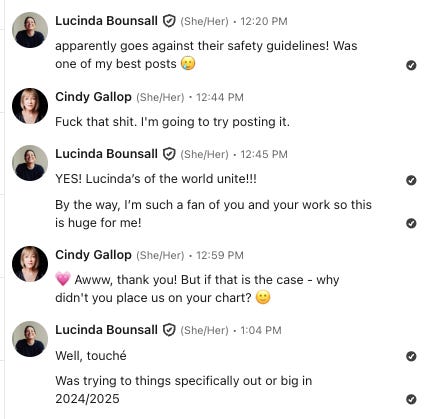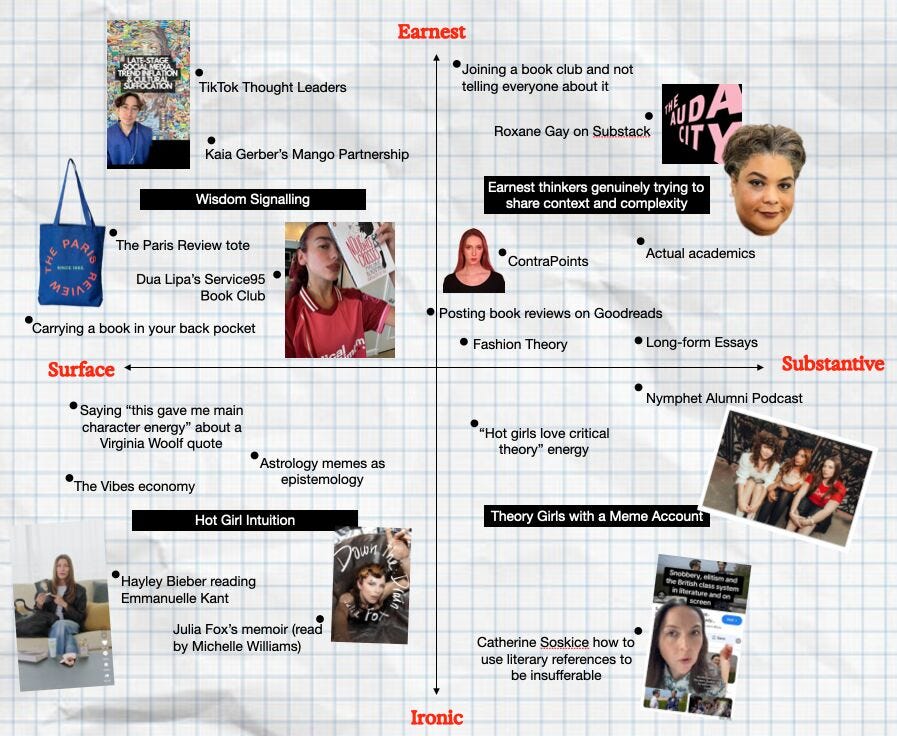Censored by LinkedIn 🧚🏻♀️ The Chart That Sparked a Conversation
Even calling it “shmex” couldn’t save it, apparently, mapping cultural tension is too much for the algorithm.
Earlier this week, I posted the quadrant chart above as part of an ongoing series where I map modern cultural signals (the first topic was on performative intelligence, see below). This one? Youth, sex, and the strange paradoxes shaping how young people think about it. Mapping things like the rise of the Manosphere against Harry Styles Fan Fic, to name a few. It was meant to be a light, fun interrogation of how culture and discourse net out around modern sexuality.
But LinkedIn (or someone on LinkedIn 👀) didn’t appreciate my take. LinkedIn quietly removed the post. No explanation. No warning. Just… gone. Apparently it didn’t comply with LinkedIn’s professional Community Politics. As if mapping trends in culture that pertain to sex and sexuality is somehow not professional. It’s not like I was, I don’t know, sliding into young women’s DMs to proposition them, which, let’s be honest, happens ALL. THE. TIME on the platform!!!
What’s especially wild is that before it was taken down, the post was getting some of the best engagement I’ve ever had; thoughtful comments, real discussion, people genuinely enjoying the content and adding their perspectives. Even my actual hero, Cindy Gallop, dropped into the comments (making my entire week) to ask why MakeLoveNotPorn hadn’t made it onto the graph (sorry Cindy!!). It was exactly the kind of smart, generous cultural discourse platforms should be encouraging, not, say, “25 lessons I learned about B2B marketing from the death of my childhood dog.” So it was disappointing (if not entirely surprising) that LinkedIn felt the need to take it down. Talking about how young people navigate sex, identity, and power isn’t unprofessional. It’s necessary, and it’s literally part of what cultural researchers do.
There were, of course, a couple of men questioning why the “male elements” I’d plotted, things like incel culture, “monk mode”, and the manosphere, didn’t appear on the expressive side of the map. As if I had to explain why rage, repression, and self-denial don’t quite qualify as empowered sexual expression? That’s sort of the point. The cultural signals around masculinity and sex right now are overwhelmingly shaped by control, fear, and avoidance and the map reflects that imbalance.
So! All that to say, moving forward, all my quadrant charts (and other cultural breakdowns) will live here, unfiltered, uncensored, and as spicy as I deem fit, right here on Substack! Stay tuned for more and I will be taking requests for what to feature in upcoming charts!
Sibling is a small but mighty strategy studio built for how brand teams (actually) work. If you’re looking for sharp strategic thinking, get in touch hello@sibling.studio.






